Sarah Sundin's Blog, page 151
December 7, 2021
Remember Pearl Harbor Tour – The US Navy’s Role at Pearl Harbor
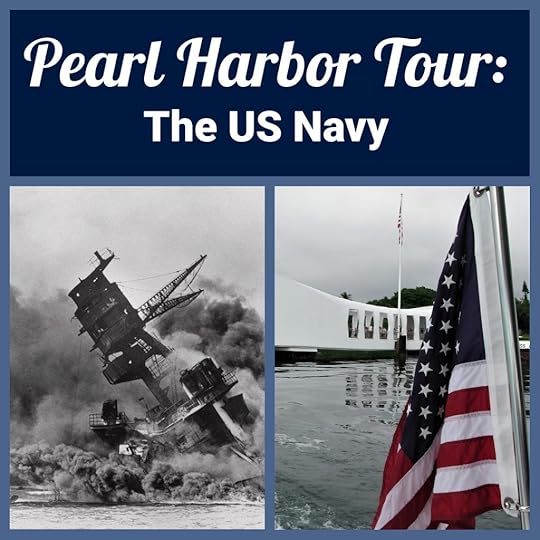
Today marks the 80th anniversary of the attack on Pearl Harbor that launched the United States into World War II. In 2016 I was privileged to visit Pearl Harbor with my husband. This week I’m sharing photographs from our visit, plus some historical background.
I hope these posts help you reflect on the gravity of the attack and the sacrifice of the 2403 servicemen and civilians who died that day. Let’s never forget the lessons of that day.
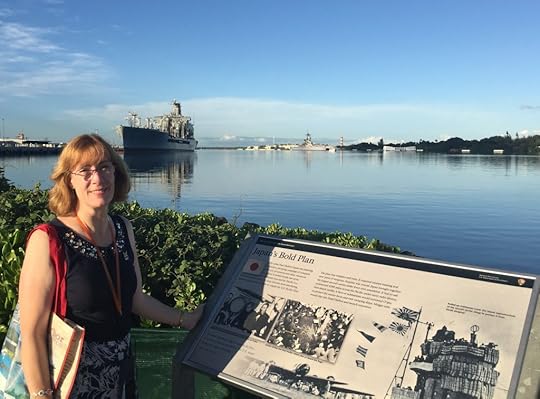
Sarah Sundin at Pearl Harbor, Hawaii, 7 Nov 2016 (Photo: Sarah Sundin)
On Monday, I shared about the role of aviation during the attack and showed photos from the Pearl Harbor Aviation Museum. Today I’ll share about the Navy’s role during the attack, along with photos from the USS Arizona Memorial. On Wednesday, I’ll discuss the road from Pearl Harbor to victory, along with photos from the submarine USS Bowfin and the battleship USS Missouri, where the Japanese signed the surrender documents officially ending World War II on Sept. 2, 1945.
The US Navy’s Role at Pearl HarborThe United States established a naval station at Pearl Harbor in 1899, and in May 1940, President Franklin Roosevelt moved Pacific Fleet Headquarters from San Diego to Pearl Harbor as a deterrent to Japanese aggression. Such a concentration of capital ships became a tempting target as Japanese military leaders hoped to wipe out American naval strength in the Pacific so they could carry out their conquests unmolested.
On December 7, 1941, 353 Japanese planes took off from aircraft carriers north of Hawaii in a daring surprise attack. However, the first shot that day was actually fired by an American ship – and the first loss that day was Japanese. At 0645, destroyer USS Ward detected a Japanese midget submarine off the entrance to Pearl Harbor – and sank it with assistance from a Navy PBY Catalina aircraft. However, word of this contact did not spread in time.
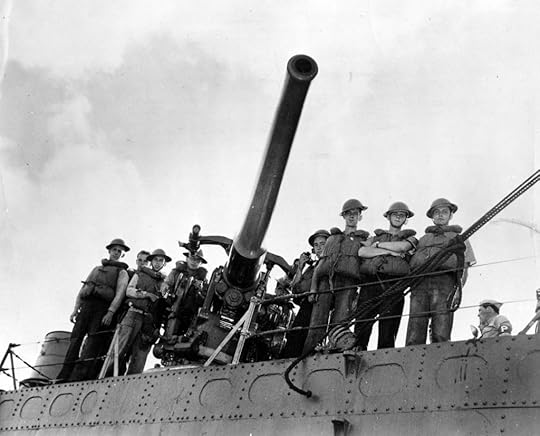
The number three gun of the destroyer USS Ward and her crew, credited with firing the first shot at Pearl Harbor (US Navy photo: NH 97446)
At 0745, the first wave of aircraft attacked, concentrating first on airfields and then on Battleship Row, with the ships lined up neatly – to prevent sabotage, which was considered a greater danger than an air raid.
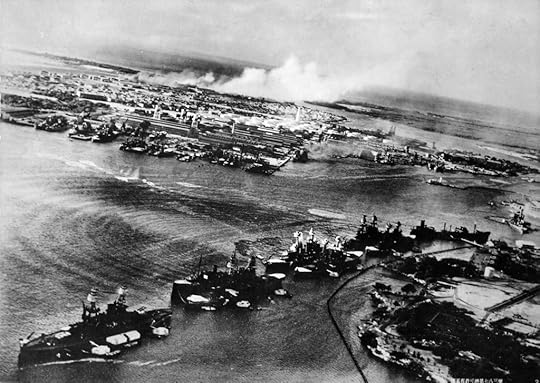
Attack on Battleship Row of Pearl Harbor, seen from a Japanese aircraft, 7 Dec 1941 (US National Archives: 80-G-30550)
At 0854, the second wave hit. By the end of the attack, five battleships had been sunk–the Arizona, Oklahoma, California, West Virginia, and Utah. The battleship USS Nevada managed to get underway and hoped to clear the channel, but damage forced the captain to make the brave and dangerous decision to beach the gigantic ship. This saved the Nevada, which went on to bombard the landing beaches of Normandy on D-Day. The California and West Virginia would eventually be raised and repaired, and the Oklahoma was salvaged, but the wrecks of the Arizona and Utah remain where they sank and have since become memorials.
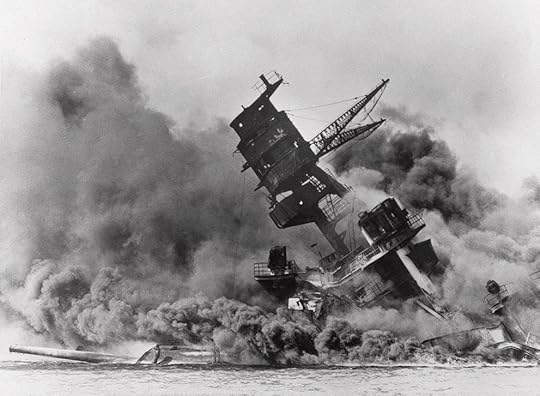
Battleship USS Arizona burning at Pearl Harbor, 7 Dec 1941 (US National Archives: ARC 1956173)
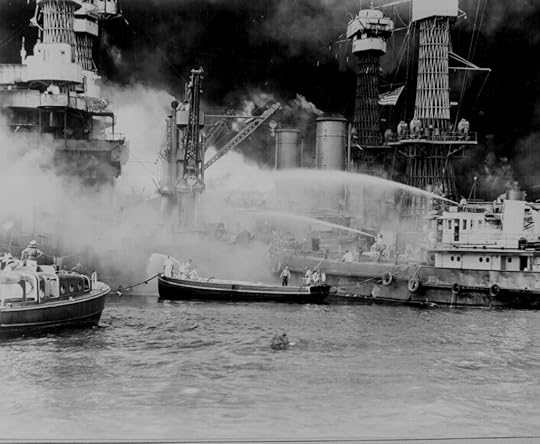
Battleship USS West Virginia during the Pearl Harbor attack, 7 Dec 1941 (US National Archives: 80-G-19947)
Of the 2403 servicemen and civilians killed that day, 2008 were members of the US Navy, and 1177 were on the USS Arizona.
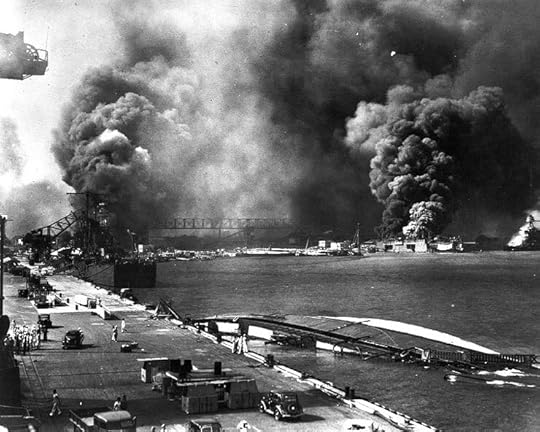
Pearl Harbor viewed from Pier 1010, 7 Dec 1941 after the attack (US National Archives: 80-G-474789)
USS Arizona MemorialEach year 2 million people visit the USS Arizona Memorial. In 2016, my husband and I were honored to join them. The tour starts at the visitor center with many sites to see and a museum. At the designated tour time, visitors watch a well-done and touching movie about the attack. Navy-run shuttle boats transport visitors to the memorial.
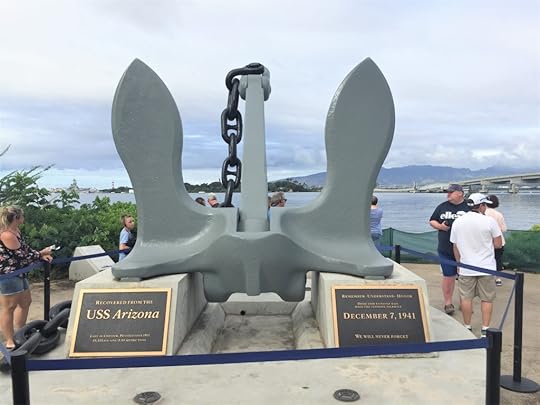
The anchor of the battleship USS Arizona, Pearl Harbor, Hawaii (Photo: Sarah Sundin, 7 Nov 2016)
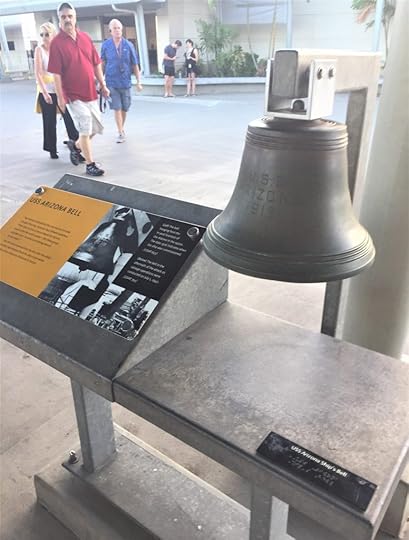
The USS Arizona’s bell, Pearl Harbor, Hawaii (Photo: Sarah Sundin, 7 Nov 2016)
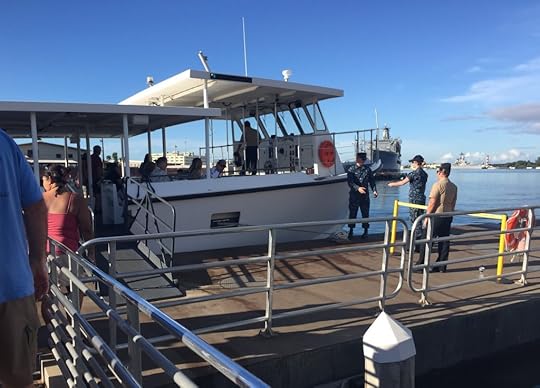
US Navy shuttle boat to the USS Arizona Memorial (Photo: Sarah Sundin, 7 Nov 2016)
The striking white memorial building straddles the sunken Arizona. An air of quiet reverence settles as you disembark and enter the memorial. Knowledgeable docents are present to answer questions and educate the public.
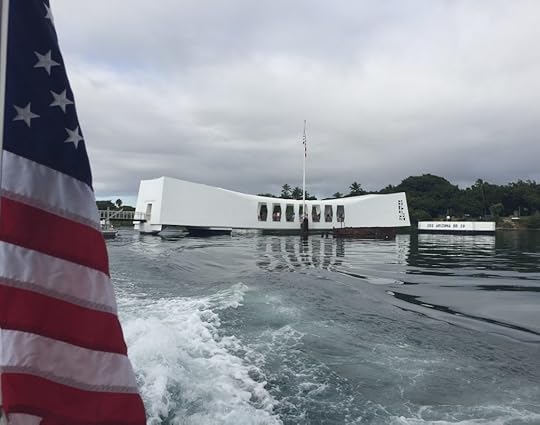
The USS Arizona Memorial, Pearl Harbor, Hawaii (Photo: Sarah Sundin, 7 Nov 2016)
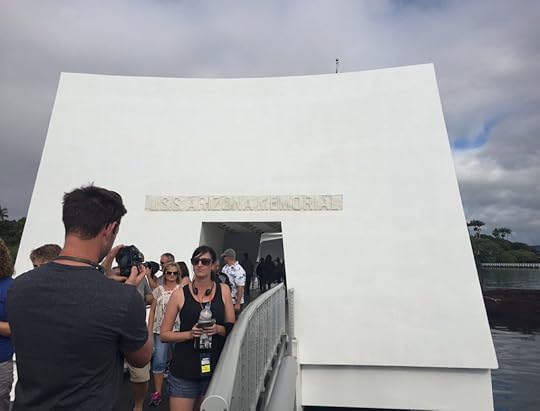
Entrance to the USS Arizona Memorial, Pearl Harbor, Hawaii (Photo: Sarah Sundin, 7 Nov 2016)
Gazing out the side windows, you look down at the submerged superstructure of the battleship, and the immensity of the loss is striking. Eighty years after the ship was sunk, oil from her tanks is still leaking to the surface, creating a sheen to the water.
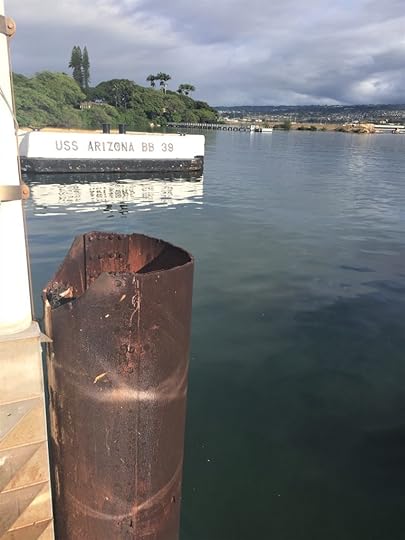
The USS Arizona’s mooring, as viewed from the memorial, Pearl Harbor, Hawaii (Photo: Sarah Sundin, 7 Nov 2016)
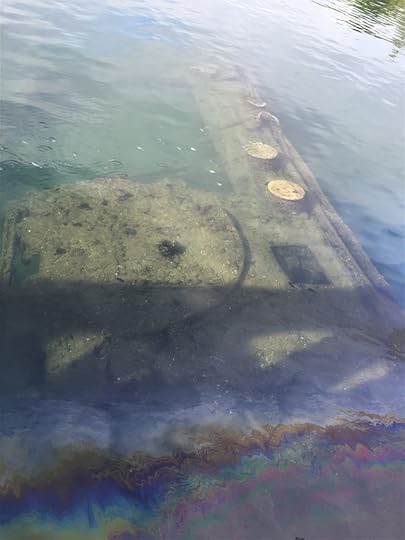
Superstructure of the USS Arizona, viewed from the memorial (Photo: Sarah Sundin, 7 Nov 2016)
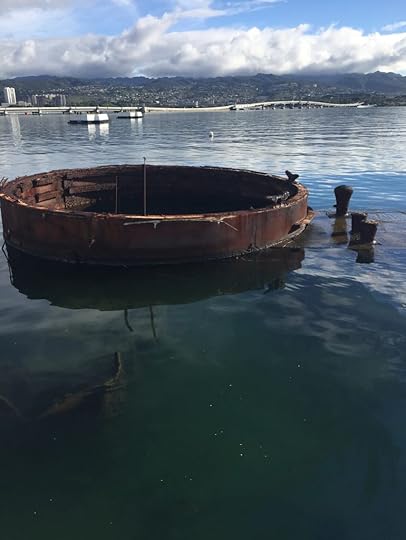
USS Arizona, viewed from the memorial; note the oil on the water (Photo: Sarah Sundin, 7 Nov 2016)
Last you enter a quiet room with a towering wall engraved with the names of the 1177 sailors and Marines who died in the attack on the Arizona. Survivors who have later had their ashes interred with their former shipmates have their names engraved on two smaller plaques below. This is incredibly moving sight, realizing the truth that those 1177 men were sons, grandsons, brothers, uncles, husbands, fathers, and friends, who left loved ones behind.
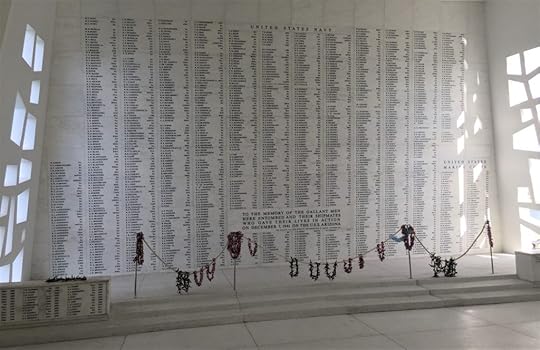
The memorial wall listing the 1177 sailors and Marines who died on the Arizona on 7 December 1941 (Photo: Sarah Sundin, 7 Nov 2016)
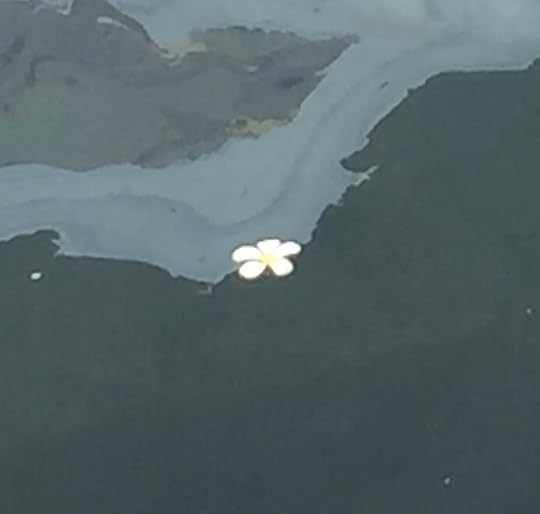
A flower on the oil from the USS Arizona (Photo: Sarah Sundin, 7 Nov 2016)
On this Pearl Harbor Day, let’s remember.
And please visit the other posts:
Day 1: The Role of Aviation During the Attack – Pictures from the Pearl Harbor Aviation Museum
Day 3: From Tragedy to Triumph – Pictures from the USS Bowfin and the USS Missouri
The post Remember Pearl Harbor Tour - The US Navy's Role at Pearl Harbor first appeared on http://www.sarahsundin.com.
Today in World War II History—December 7, 1941

Battleship USS Arizona burning at Pearl Harbor, 7 Dec 1941 (US National Archives: ARC 1956173)
80 Years Ago—Dec. 7, 1941: Japanese attack Pearl Harbor at 0755, killing 2335 military personnel and 68 civilians.
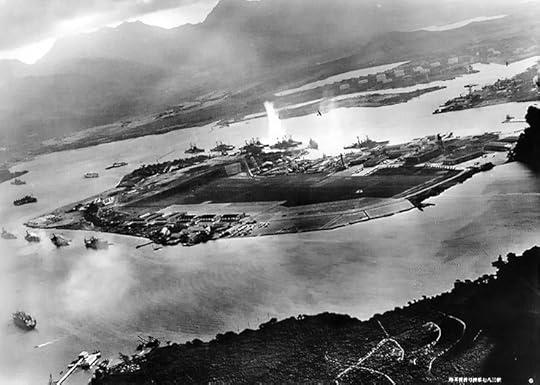
Aerial view of Ford Island in Pearl Harbor during the Japanese attack, 7 Dec 1941; photo taken from a Japanese aircraft (US Naval History & Heritage Command: NH 50930)
Japanese aircraft sink US battleships Arizona, Oklahoma, West Virginia, California, and Utah (which had been converted to an auxiliary), and damage battleship USS Nevada.
At Pearl Harbor, destroyer USS Ward fires the first shot, sinking a Japanese midget sub at 0645.
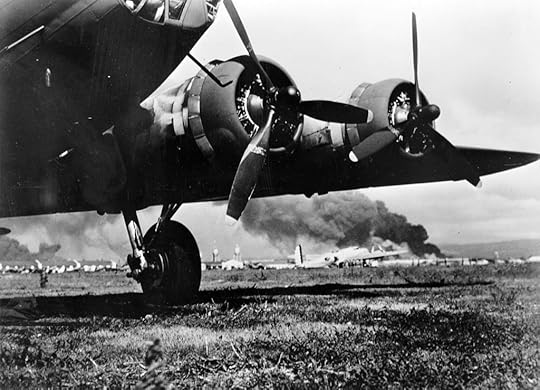
Lt. Karl T. Barthelmess’s B-17E at Hickam Air Field, after landing safely during the Japanese air raid, 7 Dec 1941; note smoke rising from Pearl Harbor (US National Archives: SC 127002)
The post Today in World War II History—December 7, 1941 first appeared on http://www.sarahsundin.com.
December 6, 2021
Remember Pearl Harbor Tour – Aviation During the Attack
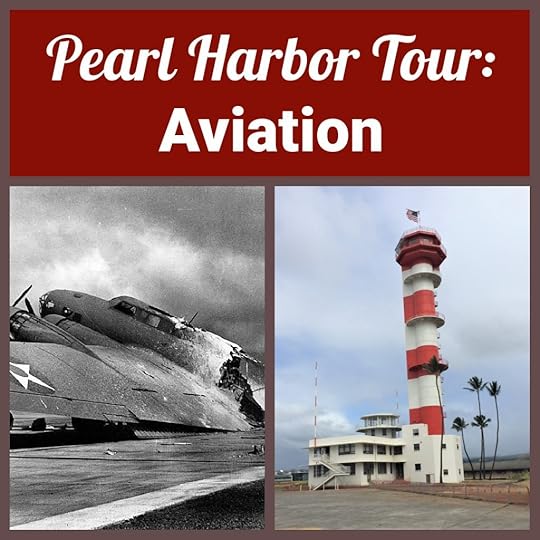
This week marks the 80th anniversary of the attack on Pearl Harbor that launched the United States into World War II. In 2016 I was privileged to visit Pearl Harbor with my husband. This week I’m sharing photographs from our visit, plus some historical background.
I hope these posts help you reflect on the gravity of the attack and the sacrifice of the 2403 servicemen and civilians who died that day. Let’s never forget the lessons of that day.

Sarah Sundin at Pearl Harbor, Hawaii, 7 Nov 2016 (Photo: Sarah Sundin)
Today I’ll share about the role of aviation during the attack and show photos from the Pearl Harbor Aviation Museum. On Tuesday, I’ll share about the Navy’s role during the attack, along with photos from the USS Arizona Memorial. On Wednesday, I’ll discuss the road from Pearl Harbor to victory, along with photos from the submarine USS Bowfin and the battleship USS Missouri, where the Japanese signed the surrender documents officially ending World War II on Sept. 2, 1945.
Aviation during the Pearl Harbor AttackThe Japanese attack on Pearl Harbor on December 7, 1941 is most known for its disastrous effect on the US Navy’s Pacific Fleet. However, aviation played an important role.
The attack itself, of course, was carried out by aircraft – 353 Japanese carrier-based fighters and bombers in two waves. A handful of American planes were able to take off and defend Pearl Harbor, downing a few Japanese planes. In all, 29 Japanese planes were lost. But 188 American planes were lost, most of them destroyed on the ground.

Aerial view of Ford Island in Pearl Harbor during the Japanese attack, 7 Dec 1941; photo taken from a Japanese aircraft (US Naval History & Heritage Command: NH 50930)
On December 6, 1941, twelve B-17 Flying Fortresses left Hamilton Field, north of San Francisco, bound for the Philippines, via Hickam Field at Pearl Harbor. My great-uncle, Roderick M. Stewart, served as a second lieutenant on one of the crews. Weighted down by gasoline for the thirteen-hour flight, they were unable to carry guns or ammunition. But why would they need them? The United States was at peace.
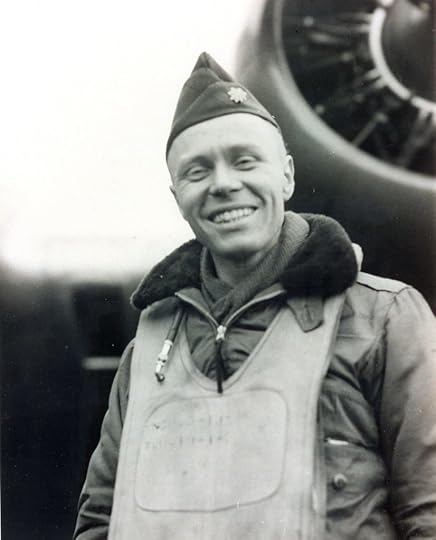
Lt. Col. Roderick Stewart
The next morning, the B-17s arrived in the middle of the Japanese attack. The bombers dodged both enemy bullets and friendly antiaircraft shells and landed where they could on fields cratered by bombs. Eight landed at Hickam Field, two at Haleiwa Field, one at Bellows Field, and one put down on Kahuku Golf Course. One of the planes was destroyed, and three were damaged. Six men were wounded, and one man was killed. My great-uncle went on to fly combat tours from Australia and England.
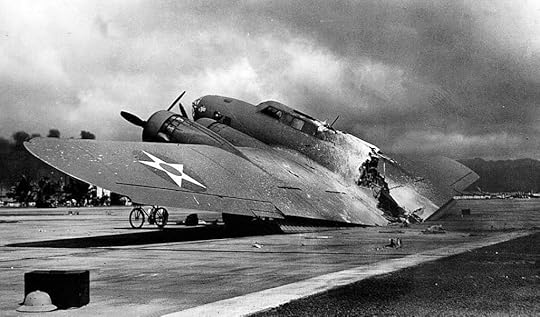
Wreck of B-17C bomber at Hickam Field, Territory of Hawaii, 7 Dec 1941 (US National Archives: 80-G-32915)
In an interesting historical side note, the brand-new Opana Radar Station detected the Japanese planes coming in for the attack, but the officer in charge, who had started duty that very morning, dismissed the findings, certain the radar blips depicted the expected B-17s. We’ll never know if an extra half hour of preparation could have prevented some of the day’s tragedy.
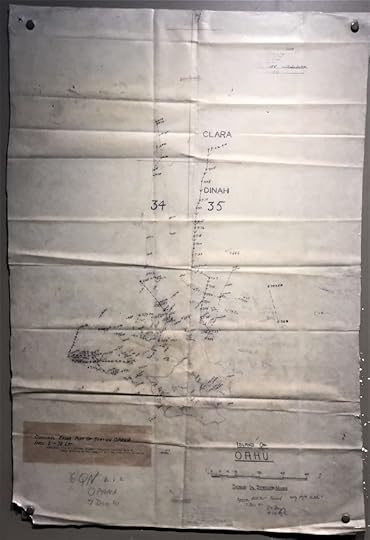
Plot from the Opana Radar Station from 7 December 1941, showing the Japanese planes approaching Pearl Harbor (Valor in the Pacific Museum. Photo: Sarah Sundin, 7 Nov 2016)
The Pearl Harbor Aviation MuseumOne of the Pearl Harbor Historic Sites is the excellent Pearl Harbor Aviation Museum. Located in Hangar 37 on Ford Island in Pearl Harbor, this museum chronicles the role of aviation in the attack on Pearl Harbor and throughout World War II in the Pacific. Nicely done with aircraft in dioramas and plenty of explanatory material, this museum is well worth a visit! The buildings date from the WWII-era and bear the scars of the attack. Please note the bullet holes from the attack in the windows of Hangar 79!
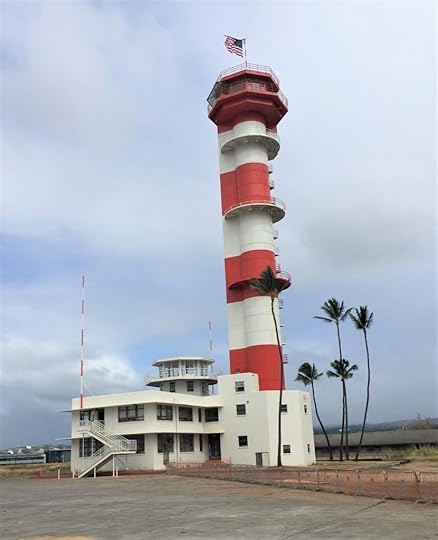
Control tower on Ford Island, Pearl Harbor, Hawaii at the Pearl Harbor Aviation Museum (Photo: Sarah Sundin, 7 Nov 2016)
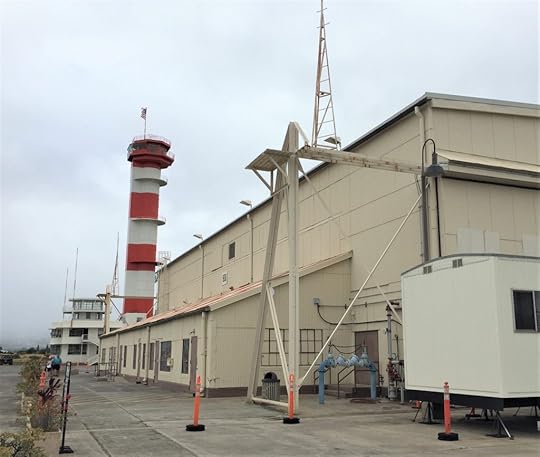
Pearl Harbor Aviation Museum, Hangar 37 and control tower, Ford Island, Pearl Harbor (Photo: Sarah Sundin, 7 Nov 2016)
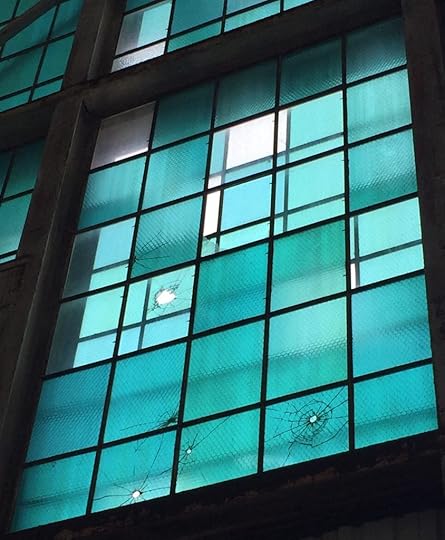
Window in Hangar 79 at the Pearl Harbor Aviation Museum, showing bullet damage from the attack on Pearl Harbor (Photo: Sarah Sundin, 7 Nov 2016)
In the main building, Hangar 37, you first see exhibits about the attack on Pearl Harbor on December 7, 1941, including a Japanese A6M Zero fighter and a US P-40 Warhawk fighter. The P-40s were responsible for downing several Japanese aircraft.
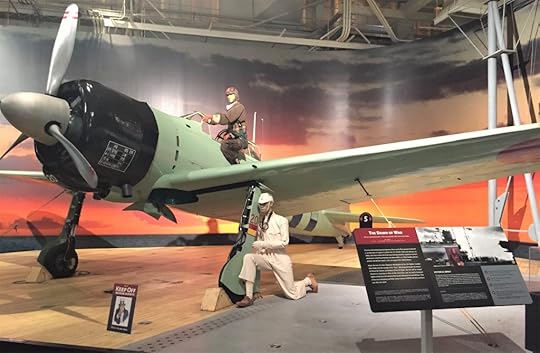
Japanese A6M Zero fighter like those used in the attack on Pearl Harbor. At the Pearl Harbor Aviation Museum, Pearl Harbor. (Photo: Sarah Sundin, 7 Nov 2016)
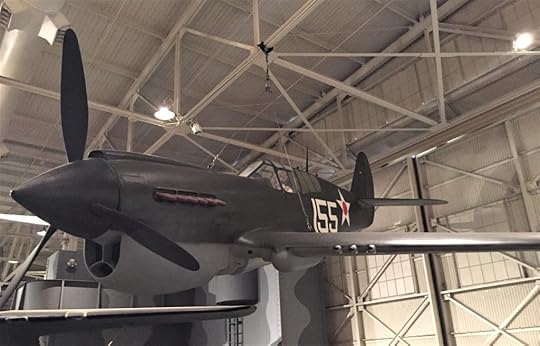
US P-40 Warhawk fighter, like those used in the defense of Pearl Harbor. At the Pearl Harbor Aviation Museum. (Photo: Sarah Sundin, 7 Nov 2016)
The museum follows the war in the Pacific. An exhibit commemorates the daring Doolittle Raid on Tokyo by carrier-based B-25 Mitchell medium bombers – which were not meant to be carrier aircraft – led by the famous Gen. Jimmy Doolittle. Other exhibits tell of the Battle of Midway (the turning point of the battle in the Pacific) and the “Cactus Air Force” which fought valiantly on Guadalcanal.
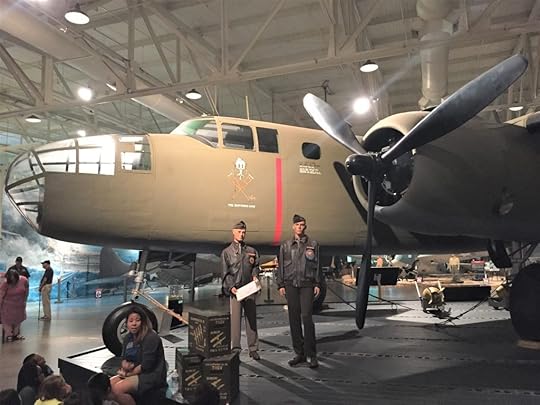
US B-25 Mitchell medium bomber as used in the Doolittle carrier raid on Tokyo on 18 April 1942. Diorama at the Pearl Harbor Aviation Museum. (Photo: Sarah Sundin, 7 Nov 2016)
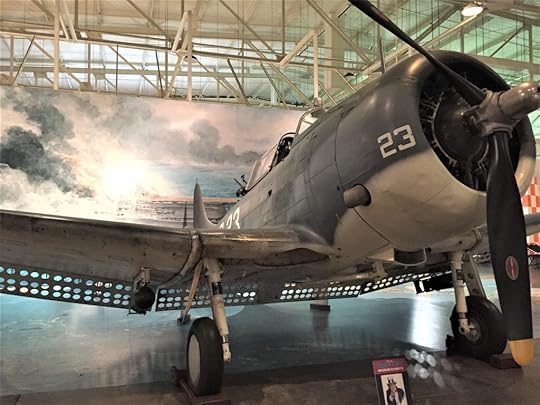
US SBD Dauntless dive-bomber like those used in the Battle of Midway 4-6 June 1942. Diorama at Pearl Harbor Aviation Museum. (Photo: Sarah Sundin, 7 Nov 2016)
Hangar 79 is a treat. Full of historic aircraft, not just from World War II, it also contains a restoration shop. One of the aircraft undergoing restoration is the Swamp Ghost. This B-17 Flying Fortress served with the US 7th Bombardment Group based in Townsville, Australia – my great-uncle’s group! After a raid on Rabaul, New Britain on February 23, 1942, the plane was damaged by enemy fighters and made a forced landing in a swamp on New Guinea. The crew made an astounding six-week trek through the jungle to safety. The B-17 lay in that swamp until rescued by aviation enthusiasts in 2006. I’m privileged to have read a manuscript about the Swamp Ghost by one of my great-uncle’s colleagues, Glen Spieth, written in 1986 when they were hoping to recover this plane. I know Uncle Rod and the men of the 7th BG would be thrilled to see this plane being so lovingly restored as they wanted. It was an honor for me to see such an amazing piece of history.
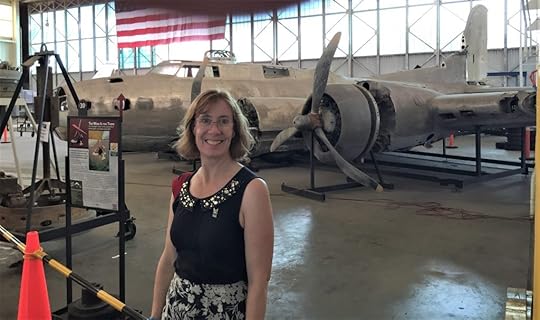
US B-17 Flying Fortress “Swamp Ghost” undergoing restoration at the Pearl Harbor Aviation Museum. (Photo: Sarah Sundin, 7 Nov 2016)
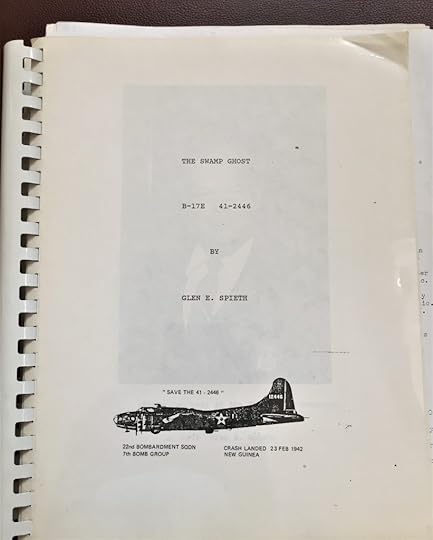
The Swamp Ghost, by Glen E. Spieth, 1986 (unpublished manuscript)
Thank you for joining me on my tour! And please visit the other posts:
Day 2: The US Navy’s Role at Pearl Harbor – Pictures from the USS Arizona Memorial
Day 3: From Tragedy to Triumph – Pictures from the USS Bowfin and the USS Missouri
The post Remember Pearl Harbor Tour - Aviation During the Attack first appeared on http://www.sarahsundin.com.
Today in World War II History—December 6, 1941
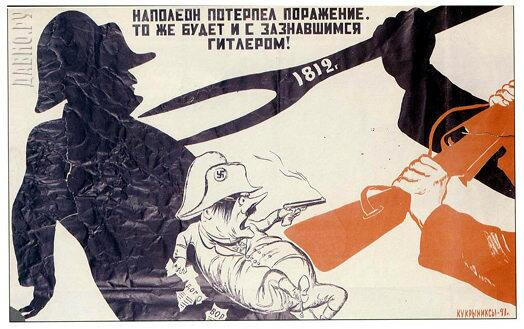
Soviet poster likening Hitler to Napoleon, mid-December 1941 (public domain)
80 Years Ago—Dec. 6, 1941: Soviet Gen. Georgi Zhukov launches a counteroffensive north of Moscow against the German army.
Battleships USS Oklahoma and USS Nevada arrive at Pearl Harbor.
The post Today in World War II History—December 6, 1941 first appeared on http://www.sarahsundin.com.
December 5, 2021
Today in World War II History—December 5, 1941
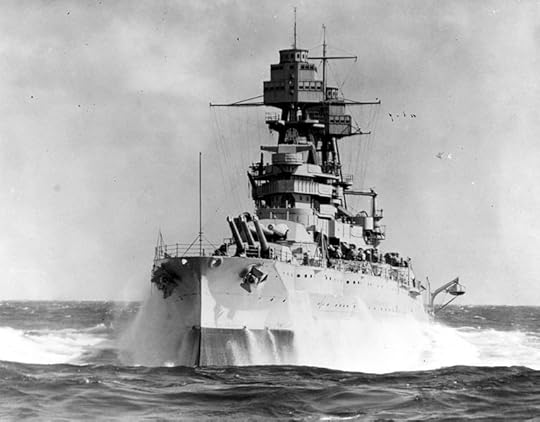
USS Arizona, 1930s (US Navy photo: 80-G-463589)
80 Years Ago—Dec. 5, 1941: Battleship USS Arizona arrives at Pearl Harbor.
USS Lexington departs Hawaii with Marine aircraft for Midway, leaving no carriers at Pearl Harbor at the time of the attack.
James J. Kilroy of Boston is hired at Fore River Shipyard in Quincy, MA, to check work of riveters; his “Kilroy Was Here” mark on ships will become legendary.
John Steinbeck’s Sea of Cortez is published.
The post Today in World War II History—December 5, 1941 first appeared on http://www.sarahsundin.com.
December 4, 2021
Today in World War II History—December 4, 1941
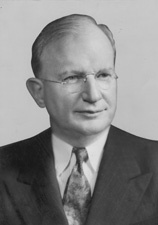
Sen. Burton Wheeler (US Senate Historical Office)
80 Years Ago—Dec. 4, 1941: Chicago Tribune and Washington Times-Herald publish news of classified, unapproved US Victory Program war plans, leaked to the papers by isolationist Sen. Burton Wheeler, creating cries of warmongering among isolationists.
Interventionist Chicago Sun is first published as foil for isolationist Chicago Tribune.
National Foundation for Infantile Paralysis approves Sister Kenny’s controversial massage treatment for polio.
The post Today in World War II History—December 4, 1941 first appeared on http://www.sarahsundin.com.
December 3, 2021
Today in World War II History—December 3, 1941
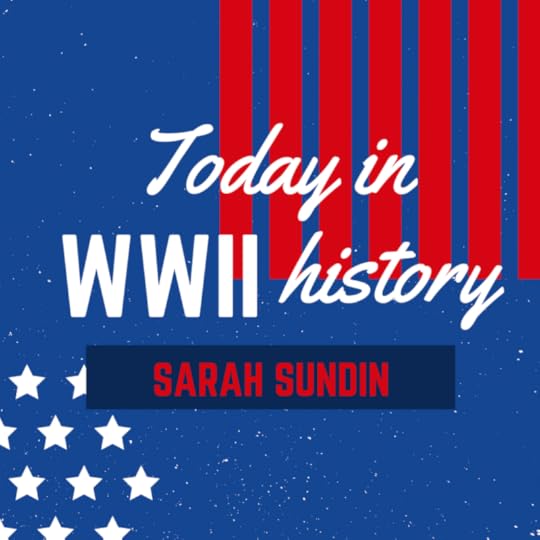
80 Years Ago—Dec. 3, 1941: Hitler issues Rationalization Decree, urging modern efficient mass production.
In South Atlantic, U-124 sinks unarmed US freighter Sagadahoc (1 killed), the sixth US ship sunk in WWII while the US was neutral.
The post Today in World War II History—December 3, 1941 first appeared on http://www.sarahsundin.com.
December 2, 2021
Today in World War II History—December 2, 1941
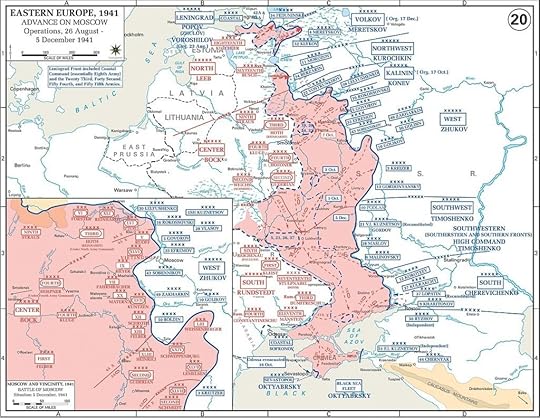
Map of the German advance on Moscow, 26 Aug-5 Dec 1941(The History Department of the United States Military Academy)
80 Years Ago—Dec. 2, 1941: German Army reaches the Moscow suburb of Khimki in sight of the Kremlin, its deepest penetration in the USSR.
Marshal Edward Rydz-Śmigły, former commander of all Polish forces, dies of heart failure in Poland, where he was participating with resistance, age 55.
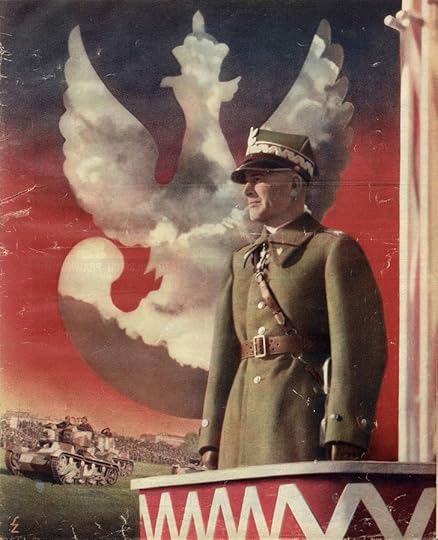
Poster featuring Polish Marshall Edward Rydz-Śmigły, 1936 (public domain via Wikipedia)
The post Today in World War II History—December 2, 1941 first appeared on http://www.sarahsundin.com.
December 1, 2021
Today in World War II History—December 1, 1941
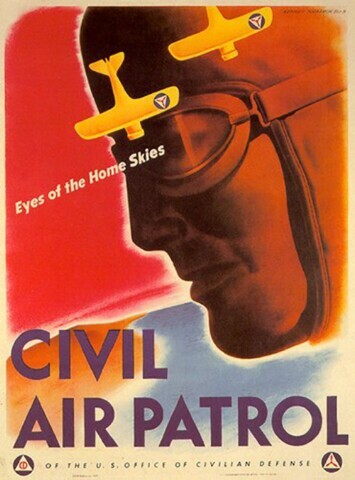
Poster of the US Civil Air Patrol, WWII
80 Years Ago—Dec. 1, 1941: US forms Civil Air Patrol for civilian pilots to aid in Civil Defense.
Japanese Navy changes its communications code, blinding the US to its movements.
The post Today in World War II History—December 1, 1941 first appeared on http://www.sarahsundin.com.
November 30, 2021
Today in World War II History—November 30, 1941
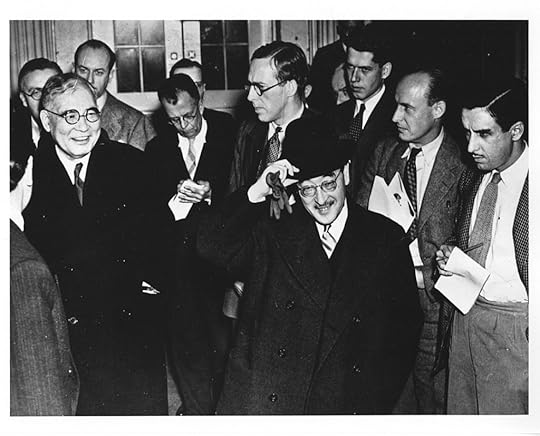
Japanese Ambassador Adm. Kichisaburo Nomura and Special Envoy Saburo Kurusu leaving US State Department, Washington, DC, 7 Dec 1941 (US National Archives: 12009100)
80 Years Ago—Nov. 30, 1941: An RAF Whitley damages German U-boat U-71 in the Bay of Biscay in the first use of air-to-surface radar.
Japanese Emperor Hirohito gives Prime Minister Tojo permission to wage war on the US; Tojo rejects US peace proposal.
The post Today in World War II History—November 30, 1941 first appeared on http://www.sarahsundin.com.



